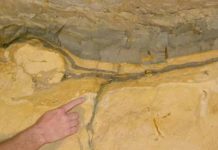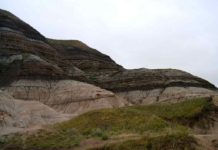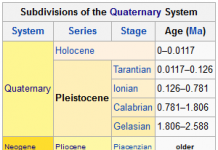The Ludlow Group are rocks deposited during the Ludlow period of the Silurian in Great Britain. This group contains the following formations in descending order:
- Cilestones, Downton Castle sandstones (90 ft./27.7 m),
- Ledbury shales 270 ft./83 m),
- Upper Ludlow rocks (140 ft./43 m),
- Aymestry limestone (up to 40 ft./12.3 m),
- Lower Ludlow rocks (350 to 780 ft./108 m-240 m).
The Ludlow group is essentially shaly in character, except towards the top, where the beds become more sandy and pass gradually into the Old Red Sandstone. The Aymestry limestone, which is irregular in thickness, is sometimes absent, and where the underlying Wenlock limestones are absent the shales of the Ludlow group graduate, downwards into the Wenlock shales. The group is typically developed between Ludlow and Aymestrey, and it occurs also in the detached Silurian areas between Dudley and the mouth of the Severn.
The Lower Ludlow rocks are mainly grey, greenish and brown mudstones and sandy and calcareous shales. They contain an abundance of fossils. The series has been zoned by means of the Graptolites by E. M. R. Wood; the following in ascending order, are the zonal forms:
- Monograptus vulgaris,
- M. Nilssoni,
- M. scanicus,
- M. tumescens and
- M. leintwardinensis.
Cyathaspis ludensis, the earliest British vertebrate fossil, was found in these rocks at Leintwardine in Herefordshire, a noted fossil locality. Trilobites are numerous (Phacops caudatus, Lichas anglicus, Homolonotus delphinocephalus, Calymene Blumenbachii); brachiopods (Leptaena rhomboidalis, Rhynchonella Wilsoni, Atrypa reticularis}, pelecypods (Cardiola interrupts, Ctenodonta sulcata) and gasteropods and cephalopods (many species of Orthoceras and also Gomphoceras, Trochoceras) are well represented. Other fossils are Ceratiocaris , Pterygotus, Protaster, Palaeocoma and Palaeodiscus.
The Upper Ludlow rocks are mainly soft mudstones and shales with some harder sandy beds capable of being worked as building-stones. These sandy beds are often found covered with ripple-marks and annelid tracks; one of the uppermost sandy layers is known as the ” Fucoid bed ” from the abundance of the seaweed-like impressions it bears. At the top of this sub-group, near Ludlow, a brown layer occurs, from a quarter of an inch to 4 in. (63 mm to 100 mm) in thickness, full of the fragmentary remains of fish associated with those of Pterygotus and mollusca. This layer, known as the ” Ludlow Bone bed,” has been traced over a very large area (see Bone Bed). The common fossils include plants (Actinophyllum, Chondrites), ostracods, phyllocarids, eurypterids, trilobites (less common than in the older groups), numerous brachiopods (Lingula minima, Chonetes striatella), gasteropods, pelecypods and cephalopods (Orthoceras bullatum). Fish include Cephalaspis, Cyathaspis, Auchenaspis. The Tilestones, Downton Castle Sandstone and Ledbury shales are occasionally grouped together under the term Downtonian. They are in reality passage beds between the Silurian and Old Red Sandstone, and were originally placed in the latter system by Sir R. I. Murchison. They are mostly grey, yellow or red micaceous, shaly sandstones. Lingula cornea, Platyschisma helicites and numerous phyllocarids and ostracods occur among the fossils.
In Denbighshire and Merionethshire the upper portion of the Denbighshire Grits belongs to this horizon: viz. those from below upwards, the Nantglyn Flags, the Upper Grit beds, the Monograptus leintwardinensis beds and the Dinas Bran beds. In the Silurian area of the Lake district the Coldwell beds, forming the upper part of the Coniston Flags, are the equivalents of the Lower Ludlow; they are succeeded by the Coniston Grits (4,000 ft./1,230 m), the Bannisdale Slates (5200 ft./1,600 m) and the Kirkby Moor Flags (2,000 ft./615 m).
In the Silurian areas of southern Scotland, the Ludlow rocks are represented in the Kirkcudbright Shore and Riccarton district by the Raeberry Castle beds and Balmae Grits (500-750 ft.). In the northern belt Lanarkshire and the Pentland Hillsthe lower portion (or Ludlovian) consists of mudstones, flaggy shales and greywackes; but the upper (or Downtonian) part is made up principally of thick red and yellow sandstones and conglomerates with green mudstones. The Ludlow rocks of Ireland include the ” Salrock beds ” of County Galway and the “Croagmarhin beds” of Dingle promontory.
Note : The above story is based on materials provided by Wikipedia











